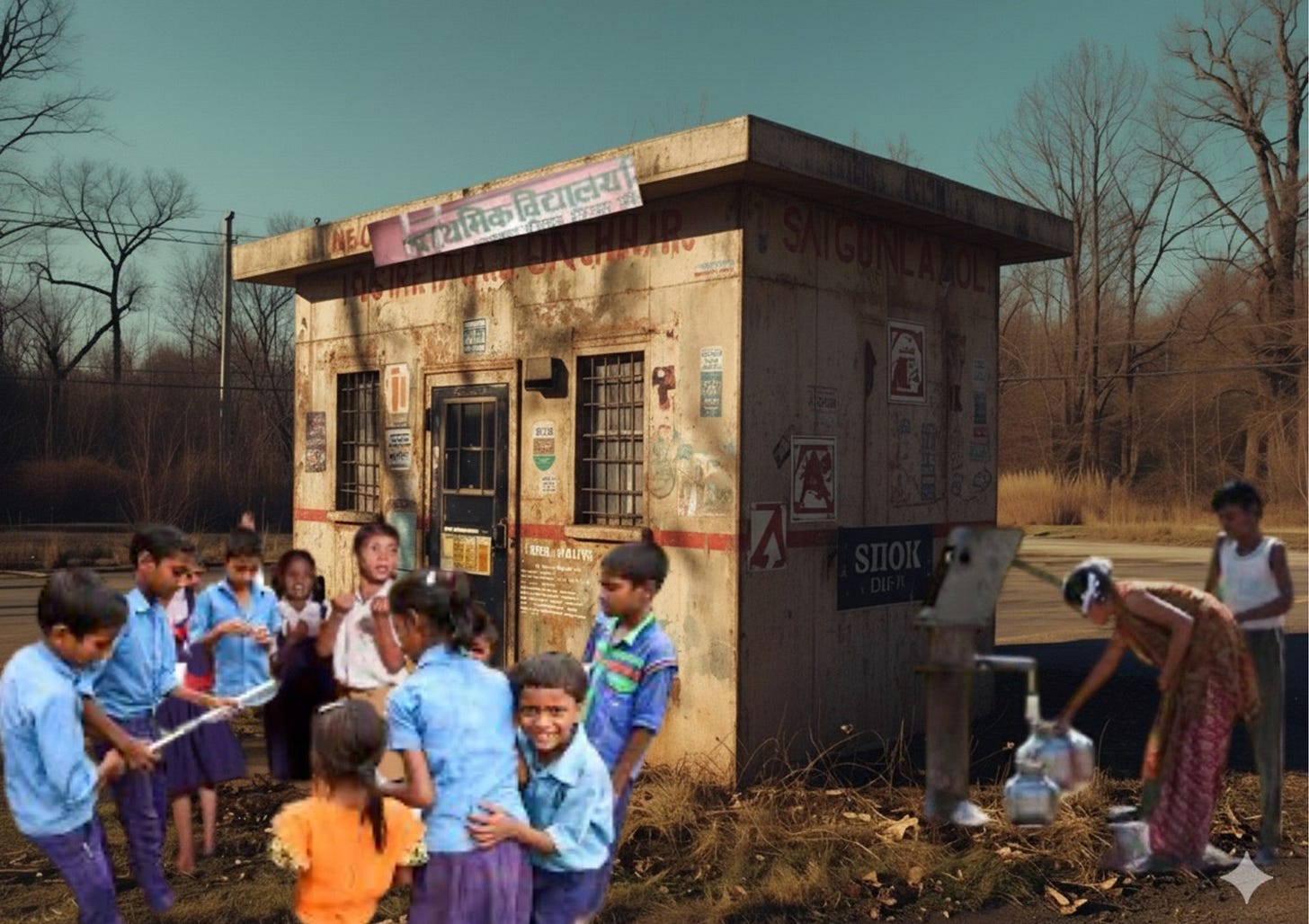When a School Has Two Rooms and Two Futures: Notes from East Champaran, Bihar
A head teacher’s account shows how reform must navigate classrooms, shared infrastructure, and the demands of daily life
View as PDF
SDG 4: Quality Education
Institutions: Ministry of Education | Education Department, Government of Bihar
When Akshita took charge as head teacher of a primary school in East Champaran, Bihar, she arrived with a degree, twelve years of classroom experience, and a hard-won appointment through the Bihar Public Service Commission (BPSC). What she didn’t find, however, was a functioning school.
The school Akshita was assigned to has two rooms, three toilets, and no office. In one room, children from Standards 3 to 5 are taught. In the other, children from Standards 1 and 2 sit beside sacks of stored foodgrains meant for the mid-day meal programme. There is no space to keep files, conduct meetings, or plan lessons.
“There is no place where I can even sit down with a notebook,” she told.
With no office or staff room, she prepares lessons, manages records, and meets parents in the same cramped rooms.
“We teach and store rations in the same space,” she said, summing up the constraints.
Routine Without Room
Akshita is assisted by two support staff. Their primary responsibilities are maintaining attendance and distributing mid-day meals, basically roles shaped less by pedagogy and more by routine, and survival. When she tried to introduce changes, one of them offered quiet resistance.
“System chalaiye, yahin mein shanti hai,” he told her. Just keep the system going, that’s where peace lies.
This system is familiar to anyone who has spent time in under-resourced schools. Registers are marked, meals are served, and physical presence often substitutes for pedagogical purposes. Teachers trying to shift the focus toward learning do so without institutional scaffolding or peer support.
This makes the state’s recent push to professionalise education all the more significant, and fraught with complexity. Bihar has recently recruited over 2.5 lakh teachers through successive BPSC-led Teacher Recruitment Exams (TREs), with 51,389 appointed in the third phase alone. Another 50,000 vacancies are expected to be filled in the upcoming TRE-4.0. While these numbers signal intent, schools like Akshita ’s reveal a deeper disconnect: reform risks being misplaced when it arrives in systems still shaped by inadequate infrastructure.
One Hand Pump, Two Realities
At Akshita’s school, the classroom competes not only with noise and neglect, but with thirst as well. In this drought-prone village, the school’s hand pump doubles as one of the few reliable sources of drinking water. Throughout the day, community members queue up to fill pots and bottles, often interrupting classes as they pass through.
“Education finds itself in competition with immediate survival needs,” Akshita explained, as she described the hand pump lines that cut through her classroom hours.
This isn’t just a lack of resources, it reflects a critical gap in planning and public service design. The school functions as both a learning space and a community water source, but without the infrastructure to support either role effectively.
Policy Arrives, But Where?
Akshita’s experience reflects a deeper structural transition underway across Bihar’s public schools - from a legacy model built around compliance, attendance, and meal distribution to one that aspires to deliver actual learning. The New Education Policy (NEP) 2020 and large-scale teacher recruitments through BPSC signal a shift in intent; but these reforms often arrive in spaces unprepared to absorb them. New teachers step into roles meant to advance education, yet find themselves constrained by inherited norms and institutional inertia.
The mismatch between policy ambition and infrastructural reality is especially stark in rural schools. NEP envisions digitally enabled, inclusive, and flexible learning environments but in places like East Champaran, many schools still lack basic classrooms, water access, or planning spaces, let alone digital infrastructure. Reform here stalls not because of apathy, but because it must take root in buildings designed for a different era.
“Sometimes I feel,” Akshita said, “we are asked to create a future from a space built for the past.”
Where the Future Must Begin
Akshita’s school is not an exception but a mirror. It reflects the quiet ambition of teachers who want to make public education work, even when the system around them hasn’t fully caught up. For reform to take root, it must be grounded not just in new appointments or revised curricula, but in the lived realities of schools like hers. Recently, the Bihar Cabinet approved ₹546 crore for school electrification and renovations, to be completed by 2026–27 which is a welcome step, but one that must translate into a real change on the ground. The question is no longer whether policy is moving forward, but whether it is carrying the school with it. Until then, two futures will continue to sit side by side in the same room: one imagined, one endured.
View as PDF
The teacher’s identity has been anonymised at her request. All other details are based on her account and have been approved for publication. This piece was prepared with assistance from Ms. Mansi Sharma, a member of the editorial team at The Policy Edge.


